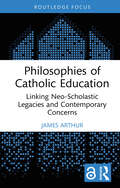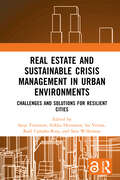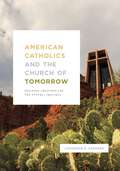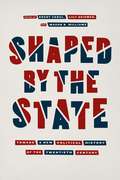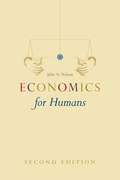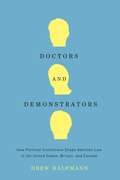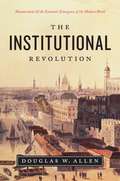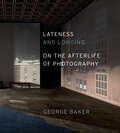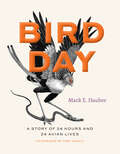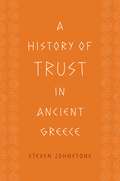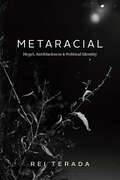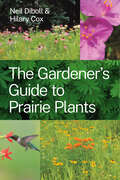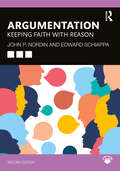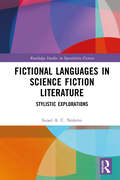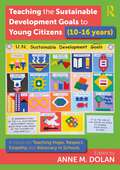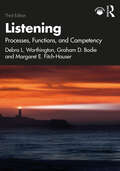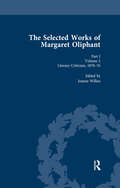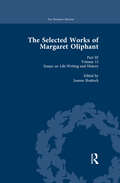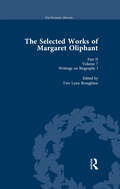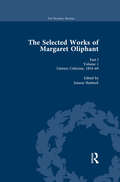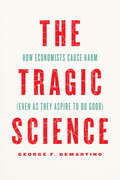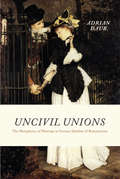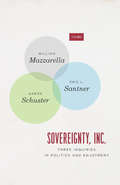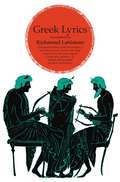- Table View
- List View
Conference Interpreting: A Student’s Practice Book
by Andrew GilliesConference Interpreting: A Student’s Practice Book brings together a comprehensive compilation of tried and tested practical exercises which hone the sub-skills that make up successful conference interpreting. Unique in its exclusively practical focus, this book serves as a reference for students and teachers seeking to solve specific interpreting-related difficulties. By breaking down the necessary skills and linking these to the most relevant and effective exercises, students can target their areas of weakness and work more efficiently towards greater interpreting competence. This second edition includes a comprehensive update of the text, with new exercises and revised example speeches throughout, as well as three entirely new chapters on Activation, Voice and Early Simultaneous Exercises.Split into four Parts, this book includes a detailed introduction offering general principles for effective practice drawn from the author’s own extensive experience as an interpreter and interpreter-trainer. The second ‘language’ section covers language enhancement at this very high level, an area that standard language courses and textbooks are unable to deal with. The last two sections cover the key sub-skills needed to effectively handle the two components of conference interpreting: simultaneous and consecutive interpreting. This book is not language-specific and, as such, is an essential resource for all interpreting students, regardless of their language combination.
Philosophies of Catholic Education: Linking Neo-Scholastic Legacies and Contemporary Concerns
by James ArthurThis seminal volume takes an interdisciplinary approach to presenting an authoritative account of contemporary philosophies of Catholic education, intersecting the substantive boundaries of education, religious studies, philosophy, and theology to ultimately re-examine these philosophies and reinvigorate the authentic aspects of the Catholic educational endeavour.Against the backdrop of an increasingly volatile debate between liberal and conservative values within Catholic educational and theological settings, chapters provide a thorough and judicious blending of historical accuracy with contemporary urgency. Combining a diversity of knowledge and historical account – including discussion on Thomism, Christian existentialism, and ideologically oppositional philosophies – the book argues that philosophies of Catholic education are in a new process of evolution necessary in order to justify the aims and priorities of Catholic education.This book will be of value to academics, scholars, teachers, and researchers with an interest in Roman Catholicism and the philosophy of education. Those more broadly interested in exploring the intersection between education, philosophy, and religion will also find the volume of use.The Open Access version of this book, available at www.taylorfrancis.com, has been made available under a Creative Commons Attribution-Non Commercial-No Derivatives (CC-BY-NC-ND) 4.0 license.
Real Estate and Sustainable Crisis Management in Urban Environments: Challenges and solutions for resilient cities
by Sara Wilkinson Saija Toivonen Sirkka Heinonen Ira Verma Raúl Castaño-RosaThe aim of this book is to promote the dynamic resilience of societies by identifying, analysing, and exemplifying the role of space and land use in both anticipated and unanticipated primary and secondary crisis situations. The book brings together the expertise of a unique team of researchers and methods from fields of futures studies, land use planning, social sustainability and wellbeing, architecture, spatial planning, design and real estate economics, and presents a novel understanding of the direct and indirect impacts of possible crises in the space and land use context. It goes on to discuss the concept of resilience and exemplifies potential solutions and offers a holistic and forward-looking approach for crisis management through a lens of social sustainability and wellbeing, making an important contribution to the promotion of wellbeing in the built environment, especially in terms of land and residential space and building use. This book does not only identify barriers and successful incentives in resilient crisis management but also discusses the role of different stakeholders (e.g., households, office workers, real estate owners, space occupants, firms, the public sector, etc.) in crisis management. Finally, international case studies aiming to tackle the challenging landscape of future threats are presented, along with novel tools to support the development of future policies, regulations, and management practices in the built environment, which can increase the dynamic resilience of societies. Overall, this book is essential reading for decision-makers in the public and private sectors, urban developers, space and spatial designers, architects, planners, community stakeholders, real estate investors, facility managers and crisis and corporate responsibility managers.
American Catholics and the Church of Tomorrow: Building Churches for the Future, 1925–1975
by Catherine R. OsborneIn the mid-twentieth century, American Catholic churches began to shed the ubiquitous spires, stained glass, and gargoyles of their European forebears, turning instead toward startling and more angular structures of steel, plate glass, and concrete. But how did an institution like the Catholic Church, so often seen as steeped in inflexible traditions, come to welcome this modernist trend? Catherine R. Osborne’s innovative new book finds the answer: the alignment between postwar advancements in technology and design and evolutionary thought within the burgeoning American Catholic community. A new, visibly contemporary approach to design, church leaders thought, could lead to the rebirth of the church community of the future. As Osborne explains, the engineering breakthroughs that made modernist churches feasible themselves raised questions that were, for many Catholics, fundamentally theological. Couldn’t technological improvements engender worship spaces that better reflected God's presence in the contemporary world? Detailing the social, architectural, and theological movements that made modern churches possible, American Catholics and the Churches of Tomorrow breaks important new ground in the history of American Catholicism, and also presents new lines of thought for scholars attracted to modern architectural and urban history.
Shaped by the State: Toward a New Political History of the Twentieth Century
by Lily Geismer Mason B. Williams Brent CebulAmerican political history has been built around narratives of crisis, in which what “counts” are the moments when seemingly stable political orders collapse and new ones rise from the ashes. But while crisis-centered frameworks can make sense of certain dimensions of political culture, partisan change, and governance, they also often steal attention from the production of categories like race, gender, and citizenship status that transcend the usual break points in American history. Brent Cebul, Lily Geismer, and Mason B. Williams have brought together first-rate scholars from a wide range of subfields who are making structures of state power—not moments of crisis or partisan realignment—integral to their analyses. All of the contributors see political history as defined less by elite subjects than by tensions between state and economy, state and society, and state and subject—tensions that reveal continuities as much as disjunctures. This broader definition incorporates investigations of the crosscurrents of power, race, and identity; the recent turns toward the history of capitalism and transnational history; and an evolving understanding of American political development that cuts across eras of seeming liberal, conservative, or neoliberal ascendance. The result is a rich revelation of what political history is today.
Economics for Humans
by Julie A. NelsonAt its core, an economy is about providing goods and services for human well-being. But many economists and critics preach that an economy is something far different: a cold and heartless system that operates outside of human control. In this impassioned and perceptive work, Julie A. Nelson asks a compelling question: given that our economic world is something that we as humans create, aren’t ethics and human relationships—dimensions of a full and rich life—intrinsically part of the picture?Economics for Humans argues against the well-ingrained notion that economics is immune to moral values and distant from human relationships. Here, Nelson locates the impediment to a more considerate economic world in an assumption that is shared by both neoliberals and the political left. Despite their seemingly insurmountable differences, both make use of the metaphor, first proposed by Adam Smith, that the economy is a machine. This pervasive idea, Nelson argues, has blinded us to the qualities that make us work and care for one another—qualities that also make businesses thrive and markets grow. We can wed our interest in money with our justifiable concerns about ethics and social well-being. And we can do so if we recognize that an economy is not a machine, but a living thing in need of attention and careful tending. This second edition has been updated and refined throughout, with expanded discussions of many topics and a new chapter that investigates the apparent conflict between economic well-being and ecological sustainability. Further developing the main points of the first edition, Economics for Humans will continue to both invigorate and inspire readers to reshape the way they view the economy, its possibilities, and their place within it.
Doctors and Demonstrators: How Political Institutions Shape Abortion Law in the United States, Britain, and Canada
by Drew HalfmannSince Roe v. Wade, abortion has continued to be a divisive political issue in the United States. In contrast, it has remained primarily a medical issue in Britain and Canada despite the countries’ shared heritage. Doctors and Demonstrators looks beyond simplistic cultural or religious explanations to find out why abortion politics and policies differ so dramatically in these otherwise similar countries. Drew Halfmann argues that political institutions are the key. In the United States, federalism, judicial review, and a private health care system contributed to the public definition of abortion as an individual right rather than a medical necessity. Meanwhile, Halfmann explains, the porous structure of American political parties gave pro-choice and pro-life groups the opportunity to move the issue onto the political agenda. A groundbreaking study of the complex legal and political factors behind the evolution of abortion policy, Doctors and Demonstrators will be vital for anyone trying to understand this contentious issue.
The Institutional Revolution: Measurement and the Economic Emergence of the Modern World (Markets And Governments In Economic Hist Ser.)
by Douglas W. AllenFew events in the history of humanity rival the Industrial Revolution. Following its onset in eighteenth-century Britain, sweeping changes in agriculture, manufacturing, transportation, and technology began to gain unstoppable momentum throughout Europe, North America, and eventually much of the world—with profound effects on socioeconomic and cultural conditions.In The Institutional Revolution, Douglas W. Allen offers a thought-provoking account of another, quieter revolution that took place at the end of the eighteenth century and allowed for the full exploitation of the many new technological innovations. Fundamental to this shift were dramatic changes in institutions, or the rules that govern society, which reflected significant improvements in the ability to measure performance—whether of government officials, laborers, or naval officers—thereby reducing the role of nature and the hazards of variance in daily affairs. Along the way, Allen provides readers with a fascinating explanation of the critical roles played by seemingly bizarre institutions, from dueling to the purchase of one’s rank in the British Army. Engagingly written, The Institutional Revolution traces the dramatic shift from premodern institutions based on patronage, purchase, and personal ties toward modern institutions based on standardization, merit, and wage labor—a shift which was crucial to the explosive economic growth of the Industrial Revolution.
Lateness and Longing: On the Afterlife of Photography (Abakanowicz Arts and Culture Collection)
by George BakerHow a generation of women artists is transforming photography with analogue techniques. Beginning in the 1990s, a series of major artists imagined the expansion of photography, intensifying its ideas and effects while abandoning many of its former medium constraints. Simultaneous with this development in contemporary art, however, photography was moving toward total digitalization. Lateness and Longing presents the first account of a generation of artists—focused on the work of Zoe Leonard, Tacita Dean, Sharon Lockhart, and Moyra Davey—who have collectively transformed the practice of photography, using analogue technologies in a dissident way and radicalizing signifiers of older models of feminist art. All these artists have resisted the transition to the digital in their work. Instead—in what amounts to a series of feminist polemics—they return to earlier, incomplete, or unrealized moments in photography’s history, gravitating toward the analogue basis of photographic mediums. Their work announces that photography has become—not obsolete—but “late,” opened up by the potentially critical forces of anachronism. Through a strategy of return—of refusing to let go—the work of these artists proposes an afterlife and survival of the photographic in contemporary art, a formal lateness wherein photography finds its way forward through resistance to the contemporary itself.
Bird Day: A Story of 24 Hours and 24 Avian Lives (Earth Day Ser.)
by Mark E. HauberAn hourly guide that follows twenty-four birds as they find food, mates, and safety from predators. From morning to night and from the Antarctic to the equator, birds have busy days. In this short book, ornithologist Mark E. Hauber shows readers exactly how birds spend their time. Each chapter covers a single bird during a single hour, highlighting twenty-four different bird species from around the globe, from the tropics through the temperate zones to the polar regions. We encounter owls and nightjars hunting at night and kiwis and petrels finding their way in the dark. As the sun rises, we witness the beautiful songs of the “dawn chorus.” At eleven o’clock in the morning, we float alongside a common pochard, a duck resting with one eye open to avoid predators. At eight that evening, we spot a hawk swallowing bats whole, gorging on up to fifteen in rapid succession before retreating into the darkness. For each chapter, award-winning artist Tony Angell has depicted these scenes with his signature pen and ink illustrations, which grow increasingly light and then dark as our bird day passes. Working closely together to narrate and illustrate these unique moments in time, Hauber and Angell have created an engaging read that is a perfect way to spend an hour or two—and a true gift for readers, amateur scientists, and birdwatchers.
A History of Trust in Ancient Greece
by Steven JohnstoneAn enormous amount of literature exists on Greek law, economics, and political philosophy. Yet no one has written a history of trust, one of the most fundamental aspects of social and economic interaction in the ancient world. In this fresh look at antiquity, Steven Johnstone explores the way democracy and markets flourished in ancient Greece not so much through personal relationships as through trust in abstract systems—including money, standardized measurement, rhetoric, and haggling.Focusing on markets and democratic politics, Johnstone draws on speeches given in Athenian courts, histories of Athenian democracy, comic writings, and laws inscribed on stone to examine how these systems worked. He analyzes their potentials and limitations and how the Greeks understood and critiqued them. In providing the first comprehensive account of these pervasive and crucial systems, A History of Trust in Ancient Greece links Greek political, economic, social, and intellectual history in new ways and challenges contemporary analyses of trust and civil society.
Metaracial: Hegel, Antiblackness, & Political Identity
by Rei TeradaA formidable critical project on the limits of antiracist philosophy. Exploring anxieties raised by Atlantic slavery in radical enlightenment literature concerned about political unfreedom in Europe, Metaracial argues that Hegel's philosophy assuages these anxieties for the left. Interpreting Hegel beside Rousseau, Kant, Mary Shelley, and Marx, Terada traces Hegel's transposition of racial hierarchy into a hierarchy of stances toward reality. By doing so, she argues, Hegel is simultaneously antiracist and antiblack. In dialogue with Black Studies, psychoanalysis, and critical theory, Metaracial offers a genealogy of the limits of antiracism.
The Gardener's Guide to Prairie Plants (Emersion: Emergent Village Resources For Communities Of Faith Ser.)
by Neil Diboll Hilary CoxA comprehensive and beautifully illustrated reference for all gardeners passionate about native plants and prairie restoration. The Gardener’s Guide to Prairie Plants is the one-stop compendium for all gardeners aspiring to use native prairie plants in their gardens. Neil Diboll and Hilary Cox—two renowned prairie gardeners—compile more than four decades’ worth of research to offer a wide-ranging and definitive reference for starting and maintaining prairie and meadow gardens and restorations. Alongside detailed synopses of plant life cycles, meticulous range maps, and sweeping overviews of natural history, Diboll and Cox also include photographs of 148 prairie plants in every stage of development, from seedling to seedhead. North America’s grasslands once stretched from the Blue Ridge to the Rocky Mountains, and from Texas to Manitoba, blanketing the mid-continent with ecologically important, garden-worthy, native species. This book provides all the inspiration and information necessary for eager native planters from across the country to welcome these plants back to their landscapes. The Gardener’s Guide to Prairie Plants is a must-have reference for gardeners, restorationists, and every flora fan with a passion for native plants, prairies and meadows.
Argumentation: Keeping Faith with Reason
by Edward Schiappa John P. NordinThis extensively updated second edition provides a comprehensive introduction to argumentation skills for undergraduates.Clearly written, with minimal technical jargon, the book features many contemporary real-world examples. Through a unique conceptual framework, students will learn how to assemble a coherent logical argument, assess sources, and organize and present written and verbal arguments. The authors use the Toulmin model throughout to present issues and clarify concepts and have expanded the model to show how it can be used to examine real-world arguments. This new edition provides a deeper focus on value claims and credibility. It also shows students how to assess fake news, misinformation, and post-truth and incorporates more social scientific theories of persuasion such as the Elaboration Likelihood Model.Argumentation: Keeping Faith with Reason is an ideal textbook for undergraduate courses in argumentation, persuasion, critical thinking, and informal logic.An Instructor’s Manual including advice on how to teach each section, sample quizzes, and additional examples is available at https://routledge.com/9781032541228.
Fictional Languages in Science Fiction Literature: Stylistic Explorations (Routledge Studies in Speculative Fiction)
by Israel A. NolettoFictional Languages in Science Fiction Literature surveys a large number of fictional languages, those created as part of a literary world, to present a multifaceted account of the literary phenomenon of glossopoesis (language invention). Consisting of a few untranslated sentences, exotic names, or even fully-fledged languages with detailed grammar and vocabulary, fictional languages have been a common element of English-language fiction since Thomas More’s Utopia (1516).Different notions of the functions of such fictional languages in narrative have been proposed: as rooted in phonaesthetics and contextual features, or as being used for characterisation and construction of alterity. Framed within stylistics and informed by narrative theory, literary theory, literary pragmatics, and semiotics, this study combines previous typologies into a new 5-part reading model comprising unique analytical approaches tailored to science fiction’s specific discourse and style, exploring the relationship between glossopoesis, world-building, storytelling, interpretation, and rhetoric, both in prose and paratexts.
Teaching the Sustainable Development Goals to Young Citizens (10-16 years): A Focus on Teaching Hope, Respect, Empathy and Advocacy in Schools
by Anne M. DolanWith the current climate and economic crises, education for sustainability has never been more critical. This timely and essential book encourages readers to rethink our current values systems and to interrogate common assumptions about our world. Written for all educators with an interest in sustainability, chapters address several possible future scenarios for our planet, allowing readers to make more educated choices about sustainability and to transfer this knowledge to students within the classroom.Each chapter focuses on a specific Sustainable Development Goal. Beginning with a brief historical and theoretical introduction to contextualise the goal, chapters then showcase the practical activities, case studies and exemplars that teachers can adopt when teaching. Topics explored include, but are not limited to: Poverty Renewable energy Climate change Peace and justice Human rights Access to education This book is an essential classroom resource for any teacher or student teacher wishing to promote the Sustainable Development Goals and to teach for a better and brighter future.
Listening: Processes, Functions, and Competency
by Debra L. Worthington Margaret E. Fitch-Hauser Graham D. BodieThis fully revised third edition explores the essential role of listening to human communication across contexts and cultures.Based on the premise that listening is a goal-directed activity, this book blends theory with practical application and builds knowledge, insight, and skills to help the reader become a more effective listener. In this new edition, theory and research has been updated with an emphasis on how the growing reliance on mediated communication affects how individuals communicate in their personal, professional, and educational lives. It introduces students to emerging concepts and methods such as neurodiversity and fMRI as well as evolving professional and educational contexts including aural architecture and "the musical brain".Addressing listening as a cognitive process, social function, and critical professional competency, this is an essential textbook for undergraduate courses in listening and communication studies.In addition to a fully updated instructor’s manual containing discussion questions, activities and assignments, and exam questions, this new edition includes PowerPoint slides and videos. They are available at http://www.routledge.com/9781032491257.
The Selected Works of Margaret Oliphant, Part I Volume 2: Literary Criticism 1870-76
by Joanne WilkesMargaret Oliphant (1828-97) had a prolific literary career that spanned almost fifty years. She wrote some 98 novels, fifty or more short stories, twenty-five works of non-fiction, including biographies and historic guides to European cities, and more than three hundred periodical articles. This is the most ambitious critical edition of her work.
The Selected Works of Margaret Oliphant, Part III Volume 13: Essays on Life-Writing and History
by Joanne ShattockMargaret Oliphant (1828-97) had a prolific literary career that spanned almost fifty years. She wrote some 98 novels, fifty or more short stories, twenty-five works of non-fiction, including biographies and historic guides to European cities, and more than three hundred periodical articles. This is the most ambitious critical edition of her work.
The Selected Works of Margaret Oliphant, Part II Volume 7: Writings on Biography I
by Trev Lynn BroughtonMargaret Oliphant (1828-97) had a prolific literary career that spanned almost fifty years. She wrote some 98 novels, fifty or more short stories, twenty-five works of non-fiction, including biographies and historic guides to European cities, and more than three hundred periodical articles. This is the most ambitious critical edition of her work.
The Selected Works of Margaret Oliphant, Part I Volume 1: Literary Criticism 1854-69 (The\pickering Masters Ser.)
by Elisabeth Jay Joanne ShattockMargaret Oliphant (1828-97) had a prolific literary career that spanned almost fifty years. She wrote some 98 novels, fifty or more short stories, twenty-five works of non-fiction, including biographies and historic guides to European cities, and more than three hundred periodical articles. This is the most ambitious critical edition of her work.
The Tragic Science: How Economists Cause Harm (Even as They Aspire to Do Good)
by George F. DeMartinoA forceful critique of the social science that has ruled—and damaged—the modern world. The practice of economics, as economists will tell you, is a powerful force for good. Economists are the guardians of the world’s economies and financial systems. The applications of economic theory can alleviate poverty, reduce disease, and promote sustainability. While this narrative has been successfully propagated by economists, it belies a more challenging truth: economic interventions, including those economists deem successful, also cause harm. Sometimes the harm is manageable and short-lived. But just as often the harm is deep, enduring, and even irreparable. And too often the harm falls on those least able to survive it. In The Tragic Science, George F. DeMartino says what economists have too long repressed: that economists do great harm even as they aspire to do good. Economist-induced harm, DeMartino shows, results in part from economists’ “irreparable ignorance”—from the fact that they know far less than they tend to believe they know—and from disciplinary training that treats the human tolls of economic policies and interventions as simply the costs of promoting social betterment. DeMartino details the complicated nature of economic harm, explores economists’ frequent failure to recognize it, and makes a sobering case for professional humility and for genuine respect for those who stand to be harmed by economists’ practice. At a moment in history when the economics profession holds enormous power, DeMartino’s work demonstrates the downside of its influence and the responsibility facing those who practice the tragic science.
Uncivil Unions: The Metaphysics of Marriage in German Idealism & Romanticism
by Adrian Daub“What a strange invention marriage is!” wrote Kierkegaard. “Is it the expression of that inexplicable erotic sentiment, that concordant elective affinity of souls, or is it a duty or a partnership . . . or is it a little of all that?”Like Kierkegaard a few decades later, many of Germany’s most influential thinkers at the turn of the eighteenth century wondered about the nature of marriage but rejected the easy answers provided by biology and theology. In Uncivil Unions, Adrian Daub presents a truly interdisciplinary look at the story of a generation of philosophers, poets, and intellectuals who turned away from theology, reason, common sense, and empirical observation to provide a purely metaphysical justification of marriage.Through close readings of philosophers like Fichte and Schlegel, and novelists like Sophie Mereau and Jean Paul, Daub charts the development of this new concept of marriage with an insightful blend of philosophy, cultural studies, and theory. The author delves deeply into the lives and work of the romantic and idealist poets and thinkers whose beliefs about marriage continue to shape ideas about gender, marriage, and sex to the present day.
Sovereignty, Inc.: Three Inquiries in Politics and Enjoyment (TRIOS)
by William Mazzarella Aaron Schuster Eric L. SatnerWhat does the name Trump stand for? If branding now rules over the production of value, as the coauthors of Sovereignty, Inc. argue, then Trump assumes the status of a master brand whose primary activity is the compulsive work of self-branding—such is the new sovereignty business in which, whether one belongs to his base or not, we are all “incorporated.” Drawing on anthropology, political theory, philosophy, psychoanalysis, and theater, William Mazzarella, Eric L. Santner, and Aaron Schuster show how politics in the age of Trump functions by mobilizing a contradictory and convoluted enjoyment, an explosive mixture of drives and fantasies that eludes existing portraits of our era. The current political moment turns out to be not so much exceptional as exceptionally revealing of the constitutive tension between enjoyment and economy that has always been a key component of the social order. Santner analyzes the collective dream-work that sustains a new sort of authoritarian charisma or mana, a mana-facturing process that keeps us riveted to an excessively carnal incorporation of sovereignty. Mazzarella examines the contemporary merger of consumer brand and political brand and the cross-contamination of politics and economics, warning against all too easy laments about the corruption of politics by marketing. Schuster, focusing on the extreme theatricality and self-satirical comedy of the present, shows how authority reasserts itself at the very moment of distrust and disillusionment in the system, profiting off its supposed decline. A dazzling diagnostic of our present, Sovereignty, Inc., forces us to come to terms with our complicity in Trump’s political presence and will immediately take its place in discussions of contemporary politics.
Greek Lyrics: More than a Hundred Poems and Poetic Fragments from the Great Age of Greek Lyric Poetry
by Richmond LattimoreA collection of more than one hundred poems and poetic fragments from the golden age of Greek Lyric poetry. In this second edition of Greek Lyrics, translator and editor Richmond Lattimore brings together a vast assortment of seventh-and sixth-century Greek lyric, elegiac, and iambic poetry. For the Greekless student or curious scholar, these translations showcase the diversity of poetic subjects in classical antiquity, which range from love poems to medical inscriptions and drinking songs. Gracefully and robustly translated by a number of top-tier translators, this volume includes poets such as Archílochus, Callínus, Semónides of Amórgos, Hippónax, Tyrtaéus, Mimnérmus, Solon, Phocýlides, Xenóphanes, Theógnis, Terpánder, Alcman, Stesíchorus, íbycus, Sappho, Alcaéus, Anácreon, Hýbrias, Praxílla, Corínna, Simónides of Ceos, Pindar, and Bacchýlides.

